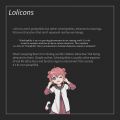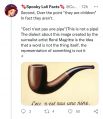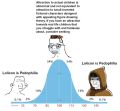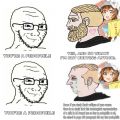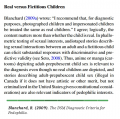One of our staff members is contributing considerably to a News Archiving service at Mu. Any well educated (Masters, PhD or above) users who wish to make comments on news sites, please contact Jim Burton directly rather than using this list, and we can work on maximising view count.
Lolicon-MAP Equivalence Debate: Difference between revisions
The Admins (talk | contribs) |
The Admins (talk | contribs) No edit summary |
||
| Line 24: | Line 24: | ||
:'''4: Muddying the waters/epistemic nitpicking:''' ''"Lolicon is by definition a broad category of art. Some Lolis (characters) are actually presented as adults. Therefore you can't just call Lolicons pedophiles - that's slanderous."'' | :'''4: Muddying the waters/epistemic nitpicking:''' ''"Lolicon is by definition a broad category of art. Some Lolis (characters) are actually presented as adults. Therefore you can't just call Lolicons pedophiles - that's slanderous."'' | ||
Clearly, this is an epistemic/etymological fallacy and an argument from consequence. It also betrays what we always suspected - that the pattern of argumentation is rooted in a both a fear of | Clearly, this is an epistemic/etymological fallacy and an argument from consequence. It also betrays what we always suspected - that the pattern of argumentation is rooted in a both a fear of negative consequences and general sociopolitical expedience. | ||
:'''5: Simplistic appeal to Japanese Culture:''' ''"The Japanese make the distinction between fiction and real abuse, since they made [[Child Pornography|CSAM]] illegal."'' | :'''5: Simplistic appeal to Japanese Culture:''' ''"The Japanese make the distinction between fiction and real abuse, since they made [[Child Pornography|CSAM]] illegal."'' | ||
| Line 34: | Line 34: | ||
''Lolicon'' is derived from the phrase "Lolita complex" (referring to the novel [[Lolita]]) - entering use in Japan in the 1970s when sexual imagery of the shōjo (idealized young girl) was expanding in the country's media. | ''Lolicon'' is derived from the phrase "Lolita complex" (referring to the novel [[Lolita]]) - entering use in Japan in the 1970s when sexual imagery of the shōjo (idealized young girl) was expanding in the country's media. | ||
The western cultural take here, is again - hopelessly simplistic. Scholarly defenses within Japan and the West are very recent and doubtless motivated by cultural embarrassment/appeal to sophistic argumentation. They are not reflective of any tendency within wider Japanese society to make a "special distinction" in favor of Lolicon - as unrelated to minor-attraction. | The western cultural take here, is again - hopelessly simplistic. Scholarly defenses within Japan and the West are ''very'' recent and doubtless motivated by cultural embarrassment/appeal to sophistic argumentation. They are not reflective of any tendency within wider Japanese society to make a "special distinction" in favor of Lolicon - as unrelated to minor-attraction. | ||
==Summary== | ==Summary== | ||
It can be concluded that the Lolicon is engaged in a patterned coping strategy (externalizing his own inner battlefield) in which he distances other MAPs in order to justify his habits. He classes anything outside of his own masturbatory impulse cycle as beyond the pale, delegitimizing | It can be concluded that the Western "Ironic Lolicon" is engaged in a patterned coping strategy (externalizing his own inner battlefield) in which he distances other MAPs in order to justify his habits. He classes anything outside of his own masturbatory impulse cycle as beyond the pale, delegitimizing all forms of pedophilia that are not fetishistic and [[Wikipedia:Egosyntonic and egodystonic|ego-dystonic]] as his own. The unfortunate consequence of this is the sadly familiar attempts to gatekeep denialistic and fetishistic pedophilia as the "good" side of a moral boundary. | ||
==Gallery of Copes== | ==Gallery of Copes== | ||
Revision as of 20:38, 18 April 2023
 | ||||||
| NewgonWiki's series on MAP culture war and war of adjacency | ||||||
|---|---|---|---|---|---|---|
|
| ||||||
| "Normalization" | "Groomer" | Trans Kids Validity Policing | Lolicon Debate MAP & LGBT Alliances | Proship Pedophobia | Vigilantism | Moral panic Masculism | Feminism | Queer Ageism | Censorship | Hoax pedophilia Anti | Pro-recovery | Alternative Initialism Transage | Kinky Kids | Assimilationism Right-wing politics | Communism Activist model |
||||||
|
| ||||||
| Template: Adj - This template |
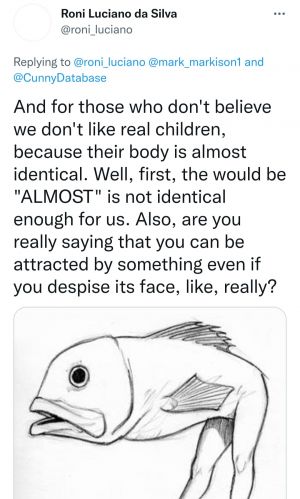
The Lolicon-MAP Equivalence Debate is a frequent low-intelligence debate that takes place within the Lolicon, MAP and various normie social media communities.
Usually, these arguments will begin when a lolicon consumer (with large amounts of lolicon on their profile) is baited by a low-intelligence bovine leftist or conservative ("anti"), who insists, with marked derogation, that the Lolicon is a pedophile who intends to harm or abuse a child. As the Lolicon is invested in his own kind of respectability politics, he responds defensively, insisting that he is "valid", not a "MAP" or "pedophile", and would never go anywhere near real child erotica. Sometimes, but not very often, the person doing the baiting is a MAP responding to overly virtuous behavior by the Lolicon.
This debate is often described as "tiresome" due to the low intelligence of the participants and their general inflexibility.
Common Lolicon copes and explanations
It is important to mention that many Lolicons insist they are not pedophiles/hebephiles and invest large amounts of time and energy seething over the mental split required to maintain this distinction. They are sometimes referred to by MAPs pejoratively as "Ironic Lolicons", and provide well-worn rationalizations:
- 1. Appeal to ethics: "We are acting ethically, since we are not consuming real child pornography."
By implying their decision to use lolicon is ethically grounded, the Lolicon effectively confirms a substitution hypothesis, i.e. he is satisfying the same underlying impulse as a pedophile or hebephile.
- 2. Appeal to fiction: "Lolicon is a fictional depiction of cute looking, elfine quasi-human forms in Japanese art. It is a drawing, and therefore we are not attracted to real children and therefore not pedophilic."
Arousal is clearly dependent upon realism, as proven by the evolution of Lolicon as a medium. It itches the same scratch, and thus psychological substitution is clearly indicated. All you are left with is a mental split (good Lolicon vs bad Pedo) based upon a crude genetic fallacy, namely an appeal to fiction: "We only idolize fictional children, therefore the idea that we are attracted to children is in the same sense, fiction".
- 3. Stylistic appeal: "Stylized images of humans (e.g. Loli facial features) are more arousing *because* of the stylistic features. We are not attracted to real children."
Accepting that as a premise, then why do Lolicons prefer "stylized" children over "stylized" adults, or indeed, "stylized" children over "stylized" pot plants? We can only conclude classical pedophilia/hebephilia or alternatively some kind of deviance fetishism in the person who finds this material arousing.
- 4: Muddying the waters/epistemic nitpicking: "Lolicon is by definition a broad category of art. Some Lolis (characters) are actually presented as adults. Therefore you can't just call Lolicons pedophiles - that's slanderous."
Clearly, this is an epistemic/etymological fallacy and an argument from consequence. It also betrays what we always suspected - that the pattern of argumentation is rooted in a both a fear of negative consequences and general sociopolitical expedience.
- 5: Simplistic appeal to Japanese Culture: "The Japanese make the distinction between fiction and real abuse, since they made CSAM illegal."
Not fully until 2014 (when posession was finally outlawed under western pressure[1][2]), which makes Japan an outlier. Even after that point, collectors were given a "grace period" to destroy their collections.[3] This is not to say that most Japanese people did not express a disapproving tolerance towards CP (as many Greeks did towards pederasty), but an appeal to Japanese culture[4] most certainly does not bolster the case of westerner "no pedo" Lolicons.
- 6: Lolicon "does not mean attraction to minors":
Lolicon is derived from the phrase "Lolita complex" (referring to the novel Lolita) - entering use in Japan in the 1970s when sexual imagery of the shōjo (idealized young girl) was expanding in the country's media.
The western cultural take here, is again - hopelessly simplistic. Scholarly defenses within Japan and the West are very recent and doubtless motivated by cultural embarrassment/appeal to sophistic argumentation. They are not reflective of any tendency within wider Japanese society to make a "special distinction" in favor of Lolicon - as unrelated to minor-attraction.
Summary
It can be concluded that the Western "Ironic Lolicon" is engaged in a patterned coping strategy (externalizing his own inner battlefield) in which he distances other MAPs in order to justify his habits. He classes anything outside of his own masturbatory impulse cycle as beyond the pale, delegitimizing all forms of pedophilia that are not fetishistic and ego-dystonic as his own. The unfortunate consequence of this is the sadly familiar attempts to gatekeep denialistic and fetishistic pedophilia as the "good" side of a moral boundary.
Gallery of Copes
- For more lolicon memes, see Memes and Graphics.
-
"There is no overlap"
-
Getting to "children" via the scenic route
-
"Schediaphilia" cope
-
Pipe (common Lolicon meme)
-
Jus smol pixels, bro!
-
Anti-Fiction meme (may as well be a MAP meme)
-
Bell curve
-
Pedos vs Lolicons
-
Blanchard/DSM debate opinions - Psychologists are not buying it
-
Rebuttal to anti-MAP Lolicons
-
Pointing to more hypocrisy
-
This famous poll was answered mainly by Ironic Lolicons
The pipe example was originally intended to demonstrate that representations of Tobacco do not encourage consumption. Lolicons use it to pretend their psychological targeting is not towards minors.
Resolution
The obvious resolution to this debate (rarely arrived at, if ever) is for the Lolicon to admit that he is minor-attracted in the most fundamental sense, but is successfully controlling those tendencies through the consumption of drawn erotica. The "anti" in this debate, should accept on his part, that there is no evidence of offending on the part of the Lolicon, and no equivalence between viewing any image and pursuing a minor. The "anti" should also consider his own insecurities and the possibility these may have arisen due to latent pedophilia.
See also
External Links
- Child pornography laws in Japan - Wikipedia.


